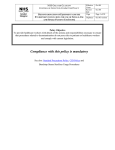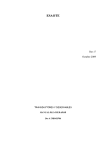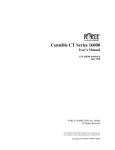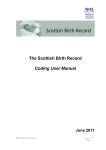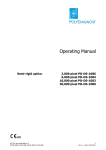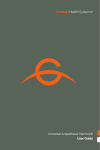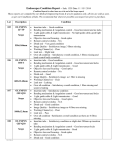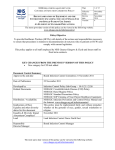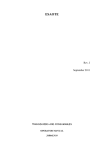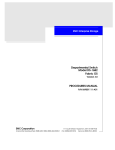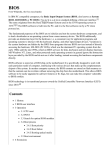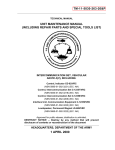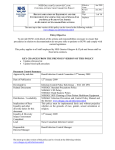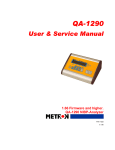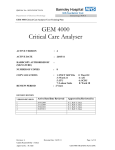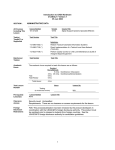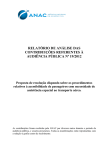Download Richard Fox comments 29th August 2013
Transcript
NHS Lanarkshire Health Protection Committee SECTION I – Decontamination of Equipment and the Environment (including the use of single-use and single-patient use items Section I Effective From October 2013 Replaces Jan 2010 Review Date September 2016 Guideline Objective This guideline aims to ensure that systems are in place to prevent and control infection and communicable disease by underpinning national polices. It outlines the criteria, responsibilities and systems required to manage specific conditions/ infections. The goal of this guideline is to protect patients, staff and the public by effective prevention and control of infection and communicable disease. Compliance with this guideline is best practice. If you have any concerns please discuss with your line manager who will consult the local Infection Control/Health Protection Team for advice I1 NHS Lanarkshire Health Protection Committee SECTION I – Decontamination of Equipment and the Environment (including the use of single-use and single-patient use items Section I Effective From October 2013 Replaces Jan 2010 Review Date September 2016 SECTION I CONTENTS Decontamination of Equipment and the Environment (including the use of single-use and single-patient use items 1 INTRODUCTION 2 THE USE OF SINGLE-USE AND SINGLEPATIENT USE EQUIPMENT 3 PRINCIPLES OF CLEANING, DISINFECTION AND STERILISATION 4 GENERAL RULES 5 REUSABLE MEDICAL DEVICES Risk Categorisation for the Decontamination of Medical Devices Correct disassembly and reassembly of surgical instruments Training 6 DISINFECTANTS Personal Protective Equipment Hazard Warning – Urine Spillages Spillages on Carpets 7 NEW EQUIPMENT PURCHASE FOR NHS, RESEARCH, TRIAL OR LOAN 8 BENCHTOP STERILISERS/AUTOCLAVES Performance Monitoring 9 DECONTAMINATION OF HEALTHCARE EQUIPMENT PRIOR TO INSPECTION, SERVICE OR REPAIR Equipment Leaving the Premises Planned Preventative Maintenance of On-Site Equipment I2 Page Nos. I 1 – I30 I4 I4 I4 I6 I7 I7 I8 I8 I8 I8 I8 I9 I9 I9 I9 I 10 I 10 I 10 NHS Lanarkshire Health Protection Committee SECTION I – Decontamination of Equipment and the Environment (including the use of single-use and single-patient use items 12 Section I Effective From October 2013 Replaces Jan 2010 Review Date September 2016 RISK CATEGORISATION OF CLINICAL PROCEDURE FOR ALL TYPES OF CREUTZFELT-JACOB DISEASE (CJD) I 12 BIBLIOGRAPHY I 13 Appendix 1 Symbols Used On Medical Packaging & Their Meanings I 15 Appendix 2 Cleaning Schedules For Clinical Staff A - Z I 16 I3 NHS Lanarkshire Health Protection Committee SECTION I – Decontamination of Equipment and the Environment (including the use of single-use and single-patient use items Section I Effective From October 2013 Replaces Jan 2010 Review Date September 2016 1. INTRODUCTION It is not always possible to identify people who are infectious from those who are not. Therefore, to ensure the safety of those being cared for, staff and visitors in the care environment must apply Standard Infection Control Precautions (SICPs). SICPs are intended for use by all staff, in all care settings, at all times, for all individuals whether infection is known to be present, or not. This guideline should be read in conjunction with the National Infection Prevention and Control Manual Chapter 1: Standard Infection Control Precautions as contained within NHSL’S Control of Infection Manual accessible through FirstPort via: http://firstport2/staff-support/healthcare-associatedinfection/Control%20of%20Infection%20Manual/Chapter%201Version%202.1.pdf This guideline provides additional actions necessary for the safe use of medical devices and appropriate use of decontamination processes in NHS Lanarkshire to minimise the risk of healthcare associated infection. Medical devices can pose significant hazards to patients if they are reprocessed inadequately or incorrectly. Additionally risks can arise from equipment that should not be reprocessed, i.e. single-use items. 2. THE USE OF SINGLE-USE AND SINGLE-PATIENT USE EQUIPMENT Prior to use packaging must be checked for single-use markings and decontamination instructions (see Appendix 1). Items marked “Single-Use” must be used once, on one patient, and discarded as clinical waste. Items marked “Single-Patient-Use” may be decontaminated and only reused on the same patient provided the manufacturer’s instructions on decontamination and reuse are followed. 3. PRINCIPLES OF CLEANING, DISINFECTION AND STERILISATION The decontamination method selected should be based on the risk of the item acting as a source or vehicle of infection and the optimum process that the item will tolerate. I4 NHS Lanarkshire Health Protection Committee SECTION I – Decontamination of Equipment and the Environment (including the use of single-use and single-patient use items Section I Effective From October 2013 Replaces Jan 2010 Review Date September 2016 PRINCIPLES OF CLEANING, DISINFECTION AND STERILISATION PROCESS DEFINITION CLEANING Physically removes contaminants including dust, soil, large numbers of microorganisms and the organic matter that protects them. • Warm water on a damp Reduces the number of micro-organisms to a safe (or relatively) safe level. Bacterial spores are not usually destroyed. • Chemical agents e.g. • Heat labile items in close o disinfectants contact with mucous membranes. DISINFECTION METHOD cloth using a measured dose of general purpose detergent solution in warm water or use detergent wipe WHEN • The environment or equipment not in close contact with mucous membranes or sterile body areas. • Prior to disinfection or sterilisation. • Physical methods [not all medical equipment refer to Manufacturers user manual] e.g.: • Items contaminated with pathogenic microbes e.g.: o body fluid spillages o boiling o low temperature steam o pasteurisation. STERILISATION A process which if specified conditions are met, renders a device sterile, i.e. from all micro-organisms and spores (BS EN 556-2 2003) • Autoclave [not all medical equipment refer to Manufacturers user manual] • Hot air oven • Ionizing radiation • Low temperature steam & formaldehyde • Ethylene oxide • Filtration • Chemical agents I5 • Items in contact with broken skin/mucous membranes • Items which enter a sterile body area. NHS Lanarkshire Health Protection Committee SECTION I – Decontamination of Equipment and the Environment (including the use of single-use and single-patient use items 4. Section I Effective From October 2013 Replaces Jan 2010 Review Date September 2016 GENERAL RULES CLEANING • carry out cleaning in a designated “dirty” area where possible • wear appropriate personal protective equipment (PPE) e.g., gloves, plastic apron and eye protection - even if an ultrasonic bath is used • use freshly prepared detergent, diluted as per manufacturer’s instructions • never pre-dilute detergents and store them • after cleaning, rinse items thoroughly with water (wipe electromedical equipment – do not immerse) • dispose of cleaning solution via sluice hopper or equipment sink - not in clinical wash hand basin. DISINFECTION • use scrupulously clean containers only • ensure thorough pre-cleaning of items prior to disinfection • never use chemical disinfection when sterilisation is required or when cleaning alone is adequate • ensure correct measured dilution • never pre-dilute disinfectants and store them • ensure items are immersed in disinfectant, the fluid entirely covering articles and penetrating into all crevices, including the insides of tubes • ensure the recommended exposure time is adhered to - no chemical agent acts immediately • never store items in a chemical disinfectant • after disinfection, rinse items thoroughly with water (wipe electro medical equipment – do not immerse). • adhere to manufacturers’ advice regarding shelf life of disinfectants. STERILISATION The use of a central sterile services department is recommended • items must be physically clean before being exposed to any sterilisation process I6 NHS Lanarkshire Health Protection Committee SECTION I – Decontamination of Equipment and the Environment (including the use of single-use and single-patient use items 5. Section I Effective From October 2013 Replaces Jan 2010 Review Date September 2016 REUSABLE MEDICAL DEVICES A medical device is any piece of equipment that is used on a patient. It includes all equipment, e.g. stethoscopes, blood pressure cuffs as well as surgical instruments. Different medical devices require different levels of decontamination The level of decontamination depends on: • where the device has been used • the type and amount of contamination • the complexity of the device RISK CATEGORISATION FOR THE DECONTAMINATION OF MEDICAL DEVICES Risk Category HIGH INTERMEDIATE LOW Description Recommendation Items in close contact with a break in the skin or mucous membrane or introduced into a sterile body area. Sterilisation - decontamination to be undertaken in a specialist facility, e.g. Sterile Services Dept. [refer to Manufacturers user manual] Items in contact with intact skin, particularly after use on infected patients or prior to use on immunocompromised patients, or items in contact with mucous membranes or body fluids. Sterilisation or disinfection required. Decontamination to be undertaken in a specialist facility, e.g. Sterile Services Dept or an area approved in conjunction with the Infection Control Team Items in contact with healthy skin or not in contact with patient. Decontamination – may be undertaken in the clinical area. I7 NHS Lanarkshire Health Protection Committee SECTION I – Decontamination of Equipment and the Environment (including the use of single-use and single-patient use items Section I Effective From October 2013 Replaces Jan 2010 Review Date September 2016 Correct disassembly and reassembly of surgical instruments It is important that the correct procedures are followed for disassembling and reassembling equipment during decontamination. Do not disassemble or reassemble any equipment unless you have been instructed or trained to do so. This training or instruction should be recorded. Training Managers must ensure that all healthcare workers are appropriately trained and have access to detailed instruction illustrating the correct procedure taking into account the manufacturer’s instructions. 6. DISINFECTANTS Disinfectants are subject to the Control of Substances Hazardous to Health (COSHH) Regulations (2002 as amended). To comply with COSHH, all disinfectants must be kept in locked cupboards. Instructions for use must be displayed close to the cupboard. When using disinfectants the approved procedure must be followed to ensure that the disinfectant is effective and does not cause harm to patients, staff, visitors, equipment or the environment. Personal protective equipment Protective clothing should be worn in accordance the COSHH assessment for the disinfection process to be used and with the National Infection Prevention and Control Manual Chapter 1: Standard Infection Control Precautions (pages 11-13) as contained within NHSL’s Control of Infection Manual accessible via through FirstPort via: http://firstport2/staff-support/healthcare-associatedinfection/Control%20of%20Infection%20Manual/Chapter%201Version%202.1.pdf Hazard warning – urine spillages NB Acidic solutions such as urine may react with the chlorine releasing agents and cause the release of chlorine vapour. Chlorine releasing agents should therefore not be used directly on urine spills. The procedure for managing blood and body fluid spillages is provided in Appendix 11 of the National Infection Prevention and Control Manual Chapter 1: Standard Infection Control Precautions as contained within NHSL’S Control of Infection Manual accessible via through FirstPort via: http://firstport2/staff-support/healthcare-associatedinfection/Control%20of%20Infection%20Manual/Chapter%201Version%202.1.pdf I8 NHS Lanarkshire Health Protection Committee SECTION I – Decontamination of Equipment and the Environment (including the use of single-use and single-patient use items Section I Effective From October 2013 Replaces Jan 2010 Review Date September 2016 Spillages on carpets Carpets are not recommended for clinical areas. Carpets in healthcare premises should be able to withstand decontamination with 10,000 parts per million available chlorine. If there are areas that do not meet this standard discolouration will likely occur during decontamination. Contact a member of the Infection Control Team for further advice and if large volume body fluid spillages occur on carpets. NB: Spillages within community healthcare settings Healthcare workers cannot use disinfectants to deal with blood and body fluid spillages occurring in the patient’s own home because of the possibility of damage. Contact a member of the Infection Control Team for further advice. 7. NEW EQUIPMENT PURCHASE FOR NHS, RESEARCH, TRIAL OR LOAN In line with MDS DB 9801 Guidance on the sale, transfer of ownership and disposal of used medical devices for hospitals and community-based organisations, the person who intends to purchase, use or loan the equipment must first seek the advice of a member of the Infection Control Team prior to purchase, or loan of any equipment which requires, and is authorised by the manufacturer for, decontamination between patients. The NHSL Business Case Form is provided in Appendix 9 of the National Infection Prevention and Control Manual Chapter 1: Standard Infection Control Precautions as contained within NHSL’S Control of Infection Manual accessible via through FirstPort via:http://firstport2/staff-support/healthcare-associatedinfection/Control%20of%20Infection%20Manual/Chapter%201Version%202.1.pdf 8. BENCHTOP STERILISERS/AUTOCLAVES Bench top sterilisers/autoclaves should only be used to decontaminate instruments if sending them to a central sterile service department is not a viable option and only after discussion with the Infection Control Team. Performance monitoring To ensure performance, equipment must be maintained and tested as per Health Technical Memorandum (HTM) 2010. Each steriliser/autoclave must have a log book in which the results of routine monitoring, examinations, tests, faults, repairs etc., are recorded. Indicator test strips only demonstrate that a load has been through a steriliser/autoclave, and cannot be relied on to assess accurately whether sterilisation has been achieved. FAILURE TO CARRY OUT PERIODIC TESTS AND MAINTENANCE COULD COMPROMISE SAFETY AND MAY HAVE LEGAL AND INSURANCE IMPLICATIONS. N.B: Anyone operating bench top sterilisers/autoclaves must contact their Estates Department for detailed guidance. I9 NHS Lanarkshire Health Protection Committee SECTION I – Decontamination of Equipment and the Environment (including the use of single-use and single-patient use items 9. Section I Effective From October 2013 Replaces Jan 2010 Review Date September 2016 DECONTAMINATION OF HEALTHCARE EQUIPMENT PRIOR TO INSPECTION, SERVICE OR REPAIR Equipment which has been contaminated by contact with blood, other body fluids or pathological specimens require decontamination prior to examination by third parties. Third parties include staff of hospital engineering and medical physics departments, manufacturers’ employees and others who perform inspection and service of equipment. Equipment which is visibly soiled must never be presented or sent to third parties for inspection, maintenance or repair. Guidance on methods of decontamination is provided in Appendix 2 of this guidance. For items not covered, advice must be obtained from the Infection Control Team. An Inspection, Servicing or Repair of Medical and Laboratory Equipment Clearance Certification Form 1 must be completed and accompany equipment, otherwise repairs may be delayed. When completing the form tick one box only, i.e., A, B or C, fill in the appropriate decontamination details and sign the form. The form is provided in Appendix 8 of the National Infection Prevention and Control Manual Chapter 1: Standard Infection Control Precautions as contained within NHSL’S Control of Infection Manual accessible via through FirstPort via:http://firstport2/staff-support/healthcare-associatedinfection/Control%20of%20Infection%20Manual/Chapter%201Version%202.1.pdf Items of equipment which cannot be decontaminated without dismantling by an engineer must be surface cleaned to remove visible soiling and labelled Danger of Infection before being sent for inspection, maintenance or repair. In these circumstances Box C should be ticked on the form. Equipment leaving the premises If equipment is to leave the premises, an Inspection, Servicing or Repair of Medical and Laboratory Equipment Clearance Certification Form 1 must be enclosed in an envelope affixed to the outside of the package. The envelope must be marked “Examine enclosed documents before unpacking” Planned preventative maintenance of on-site equipment Where planned preventative maintenance (PPM) is being carried out on site, it is considered unnecessarily onerous to complete an individual form for each item. In these circumstances, where lists of equipment scheduled for maintenance are sent to clinical areas in advance, such lists should contain a section where the clearance status of each item of equipment can be documented. Clearance Certification Form 2 may be used for clearance category A or B items only. Form 2 is provided in Appendix 8 of the National Infection Prevention and Control Manual Chapter 1: Standard Infection Control Precautions as contained within NHSL’S Control of Infection Manual. For clearance category C items an individual Form 1 must be completed. SEE FLOW CHART ON NEXT PAGE. I 10 NHS Lanarkshire Health Protection Committee SECTION I – Decontamination of Equipment and the Environment (including the use of single-use and single-patient use items Section I Effective From October 2013 Replaces Jan 2010 Review Date September 2016 DECONTAMINATION OF HEALTH CARE EQUIPMENT PRIOR TO INSPECTION, SERVICE OR REPAIR Has equipment been contaminated with blood or other potentially Has equipment been contaminated with blood or other potentially contaminated materials? contaminated materials or been used by a patient in isolation? NO Clean thoroughly. Clean thoroughly. (see A to Z for (see A to Z for appropriate method) appropriate method) Clean and disinfect Clean and disinfect thoroughly. thoroughly. (see A to Z for (see A to Z for appropriate method) appropriate method) NO YES Is dismantling necessary Is dismantling necessary before complete disinfection before complete disinfection is possible? is possible? YES Is this PPM for which Medical Is this PPM for which Medical Physics have supplied Clearance Physics have supplied C learance Certification Form 2 Certification Form 2 YES Clean and disinfect Clean and disinfect all external surfaces. all external surfaces. (see A to Z for (see A to Z for appropriate method) appropriate method) Is this PPM for which Is this PPM for which Medical Physics have Medical Physics have supplied Clearance supplied C learance Certification Form 2 Certification Form 2 NO YES Enter A in status Enter A in status column of Clearance column of C learance Certification Form 2 Certification Form 2 NO Enter B in status Enter B in status column of Clearance column of C learance Certification Form 2 Certification Form 2 Tick Box B of Clearance Tick Box B of C learance Certification Form 1 Certification Form 1 Tick Box A of Tick Box A of Clearance C learance Certification Form 1 Certification Form 1 Release/send equipment for inspection, service or repair. Release/send equipment for inspection, service or repair. (see text paragraph 3.1 if equipment leaving premises) (see text paragraph 3.1 if equipment leaving premises) I 11 Tick Box C of Clearance Tick Box C of C learance Certification Form 1 Certification Form 1 NHS Lanarkshire Health Protection Committee Section Effective From October 2013 Replaces Jan 2010 SECTION I – Decontamination of Equipment and the Review Date Environment (including the use of single-use and single-patient use items 10. I September 2016 RISK CATEGORISATION OF CLINICAL PROCEDURE FOR ALL TYPES OF CREUTZFELT-JACOB DISEASE (CJD) In addition to the Classification of Risk, there are also technical requirements for decontamination for specific instruments in relation to CJD. Please refer to SECTION W - The Management of Patients with Transmissible Spongiform Encephalopathy (TSE) including all forms of Creutzfeldt Jacob Disease (CJD) as contained within NHSL’s Control of Infection Manual accessible via http://firstport2/staff-support/healthcare-associatedinfection/Control%20of%20Infection%20Manual/Sect%20W.pdf Please contact a member of the Infection Control Team for further advice. I 12 NHS Lanarkshire Health Protection Committee Section I Effective From October 2013 Replaces Jan 2010 SECTION I – Decontamination of Equipment and the Review Date Environment (including the use of single-use and single-patient use items September 2016 BIBLIOGRAPHY Ayliffe, G. A. J., Lowbury, E. J. L., Geddes, A. M. & Williams, J. D. (2000), Control of Hospital Infection: A Practical Handbook, Chapman & Hall. Health Protection Scotland Compendium of Healthcare Associated Infection Guidance accessible via http://www.documents.hps.scot.nhs.uk/hai/hai-compendium/hai-compendium-v2-4.pdf Health Protection Scotland Standard Infection Control Precautions (National infection Prevention and Control Manual) Version 2.1 accessible via http://www.hps.scot.nhs.uk/haiic/ic/guidelinedetail.aspx?id=49785 Health Service Guidelines, HSG (93) Decontamination of Equipment Prior to Inspection, Service or Repair. Medical Devices Agency, Guidance on the Sale Transfer of Ownership and Disposal of Used Medical Devices, MDA DB 9801, Supplement 2, Oct 2001. Medical Devices Agency, Re-Usable Stainless Steel Vaginal Specula, MDA/2003/019 Medical Devices Agency, Safety Notice Enteral Feeding Systems, MDA SN 2000 (27). Medical Devices Agency, Single-Use Medical Devices: Implications and Consequences of Reuse, DB 2000 (04). Microbiology Advisory Committee to the Department of Health, Sterilization, Disinfection and Cleaning of Medical Equipment: guidance on Decontamination, Part1 Principles, Part 2 Protocols & Part 3 Procedures. Microbiology Advisory Committee to the Department of Health (1997) Sterilisation, Disinfection and Cleaning of Medical Equipment: Guidance on Decontamination, Medical Devices Agency. NHS HDL (2003) 42, Decontamination, NHS Scotland Sterile Services Provision Review Group. NHS Scotland, Sterile Services Provision Review Group, 1st Report, NHS Scotland (The Glennie Report), 2001. Safety Action Notice, Inadequate disassembly of surgical instruments prior to cleaning and sterilization risk of contamination, SAN (SC) 99/02. Safety Action Notice, Reporting of Adverse Incidents in NHS Scotland, SAN (SC) 01/01. I 13 NHS Lanarkshire Health Protection Committee Section I Effective From October 2013 Replaces Jan 2010 SECTION I – Decontamination of Equipment and the Review Date Environment (including the use of single-use and single-patient use items September 2016 Scottish Health Facilities Note 30, version 2, Infection Control in the Built Environment: Design and Planning, Property and Environmental Forum, NHS Scotland 2007 Scottish Office, Home & Health Dept / CMO (93)1, Neuro and Ophthalmic Surgery Procedures on Patients with or Suspected to Have or at Risk of Developing, CreutzfeldtJacob Disease (CJD) or Gerstmann-Straussler Syndrome (GSS). Wilson, J. (1995), Infection Control in Practice, Balliére Tindall. I 14 NHS Lanarkshire Health Protection Committee Section I Effective From October 2013 Replaces Jan 2010 SECTION I – Decontamination of Equipment and the Review Date Environment (including the use of single-use and single-patient use items SYMBOLS USED ON MEDICAL PACKAGING & THEIR MEANINGS September 2016 Appendix 1 These symbols are the most common ones appearing on medical devices and their packaging. They are explained in more detail in the British and European Standard BS EN 980: 1997 Graphical symbols for use in the labelling of medical devices. Symbols appearing on medical devices and/or their packaging must be adhered to. If a user does not understand a symbol, they should first look in the instructions for use or user manual explanation I 15 Section NHS Lanarkshire Health Protection Committee SECTION I – Decontamination of Equipment and the Environment (including the use of single-use and singlepatient use items Between Patients √ Ambubag Anaesthetic Equipment Difficult intubation trolley Intubation laryngeal mask Laryngoscope blade Laryngoscope handle Suction filter (wall/portable) √ √ √ √ √ Auroscope – Ear pieces √ Baby Equipment baby baths electric breast pump kanmed baby warmer unit and plastic mattress Baby Incubators October 2013 Replaces Jan 2010 Review Date July 2016 √ √ √ √ √ The incubating laryngeal mask airway should be washed in detergent to remove soiling and reprocessed in central sterile supplies department. Laryngoscope handles should be cleaned with detergent wipes – do not immerse. √ Appendix 2 COMMENTS Non-disposable ambu bag contains a single use bacterial filter to be disposed after use. It is advisable that laryngoscope blades are disposable, handles should also be disposable or reprocessed in central sterile supplies department Clean with warm water and detergent or detergent wipes. Dry thoroughly or use disposable. √ √ Use warm water & detergent or detergent wipes. Dry thoroughly. Breast pump pack (disposable) Water and detergent not to be used on electrical equipment. √ √ Clean with detergent wipes and dry thoroughly. If contaminated with blood or body fluids use a chlorine releasing agent. Include in weekly ward cleaning schedule. √ √ Effective From CLEANING SCHEDULES FOR CLINICAL STAFF FREQUENCY PREFERRED METHODS After Monthly Daily Weekly Soiling or Other Disposable or central sterile supplies department EQUIPMENT ITEM I I 16 Section NHS Lanarkshire Health Protection Committee SECTION I – Decontamination of Equipment and the Environment (including the use of single-use and singlepatient use items Effective From October 2013 Replaces Jan 2010 Review Date July 2016 CLEANING SCHEDULES FOR CLINICAL STAFF FREQUENCY PREFERRED METHODS After Monthly Daily Weekly Soiling or Other √ Clean with warm water and detergent or use disposable wipes. Dry thoroughly. EQUIPMENT Between Patients ITEM I Basins: plastic √ Baths/showers Shower chairs √ √ Beds & accessoriescot sides/cradles/frames mattresses Beds (Specialist) √ √ √ √ √ √ √ Bed tables √ √ √ Store inverted when not in use Damp dust weekly and clean Do not store items on the floor. with warm water and detergent or Do not use alcohol wipes on use disposable wipes between mattresses. patients. Dry thoroughly. Beds as per manufacturer’s instructions √ COMMENTS Clean with warm water and detergent. Dry thoroughly. √ Bedside lockers Appendix 2 √ Wash tops with detergent wipes daily. Wash inside with detergent wipes weekly √ Clean with warm water and detergent or detergent wipes. I 17 Section NHS Lanarkshire Health Protection Committee SECTION I – Decontamination of Equipment and the Environment (including the use of single-use and singlepatient use items EQUIPMENT Between Patients ITEM Bed Pan Holders √ I Effective From October 2013 Replaces Jan 2010 Review Date July 2016 CLEANING SCHEDULES FOR CLINICAL STAFF FREQUENCY PREFERRED METHODS After Monthly Daily Weekly Soiling or Other √ √ Clean with warm water and detergent or use disposable wipes. Dry thoroughly. If contaminated with blood or body fluids use a chlorine releasing agent. Appendix 2 COMMENTS Cleaning should be carried out in dirty sink in the sluice. Bed pan Macerator/Destructor √ Clean the outside with warm water and detergent. Dry thoroughly. Bedpan Storage Rack √ Clean with warm water and detergent or use disposable wipes. Dry thoroughly. √ Clean with warm water and detergent or use disposable wipes. Dry thoroughly. Include in weekly ward cleaning schedule. If contaminated with blood or body fluids use a chlorine releasing agent. Clean with detergent wipes. Dry thoroughly. [refer to Manufacturers user manual] Use disposable for Clostridium difficile positive patients √ Bins (Clinical Waste) Blood Pressure Cuffs √ I 18 Section NHS Lanarkshire Health Protection Committee SECTION I – Decontamination of Equipment and the Environment (including the use of single-use and singlepatient use items I Effective From October 2013 Replaces Jan 2010 Review Date July 2016 Chairs √ CLEANING SCHEDULES FOR CLINICAL STAFF FREQUENCY PREFERRED METHODS After Monthly Daily Weekly Soiling or Other √ √ Clean with warm water and detergent or detergent wipes. Dry thoroughly. If contaminated with blood or body fluids use a chlorine releasing agent. Commodes √ √ Denture Mugs √ Drip/Stands etc √ √ Duvets √ √ Earphones √ EQUIPMENT Between Patients ITEM √ √ √ Appendix 2 COMMENTS Fabric chairs are unsuitable for clinical areas. Include in weekly ward cleaning schedule. Clean with warm water and detergent or detergent wipes. Dry thoroughly. If contaminated with blood or body fluids use a chlorine releasing agent. Inspect undercarriage, handles etc If non-disposable wash with warm water and detergent. Dry thoroughly. Disposable preferred. Clean with warm water and detergent or detergent wipes. Dry thoroughly. Include in weekly ward cleaning schedule. If contaminated with blood or body fluids use a chlorine releasing agent. Water impermeable cover. Clean with warm water and detergent. Dry thoroughly. √ Clean with warm water and detergent or detergent wipes. Dry thoroughly. I 19 Include in weekly ward cleaning schedule. Section NHS Lanarkshire Health Protection Committee SECTION I – Decontamination of Equipment and the Environment (including the use of single-use and singlepatient use items Between Patients ECG Leads √ Electric Fans √ Endoscopes arthroscopes bronchoscopes colonoscope cystoscopes gasrtoscopes laparoscopes etc √ Finger Probes for O2 Saturation Monitors √ Effective From October 2013 Replaces Jan 2010 Review Date July 2016 CLEANING SCHEDULES FOR CLINICAL STAFF FREQUENCY PREFERRED METHODS After Monthly Daily Weekly Soiling or Other Clean with detergent wipes. Dry thoroughly. [refer to Manufacturers user manual] EQUIPMENT ITEM I √ √ I 20 Appendix 2 COMMENTS If all areas of the equipment are accessible clean with detergent wipes. Dry thoroughly. If unable to do so cleaning should be carried out by Estates Department on request. Include in weekly ward cleaning schedule. Complete a decontamination certificate before sending equipment to Estates Department. Manually cleaned to remove soil and then reprocessed in an automated endoscope washer. Follow local guidance on the decontamination of endoscopes Clean with detergent wipes. Dry thoroughly. [refer to Manufacturers user manual] Disposable preferred. Section NHS Lanarkshire Health Protection Committee SECTION I – Decontamination of Equipment and the Environment (including the use of single-use and singlepatient use items Between Patients Flower Vases Glucometers √ Ice bucket for Swann Ganz Catheters √ √ Ice Cube Making Machine Infusion/EF Pumps √ Lead Aprons √ √ Keyboards √ Effective From October 2013 Replaces Jan 2010 Review Date July 2016 CLEANING SCHEDULES FOR CLINICAL STAFF FREQUENCY PREFERRED METHODS After Monthly Daily Weekly Soiling or Other √ Renew water daily. Clean with warm water and detergent or clean in dishwasher. Dry thoroughly. EQUIPMENT ITEM I √ Appendix 2 COMMENTS Store dry and inverted. Not to be used in specialist units e.g. Burns Unit, ITU, and SCBU etc. Clean with detergent wipes. Dry thoroughly. If contaminated with blood or body fluids use a chlorine releasing agent. Refer to manufacturer’s instructions. √ Clean with warm water and detergent. Dry thoroughly. Renew ice daily. √ Follow manufacturer’s instructions. Ice to be used for clinical purposes only. Include in weekly ward cleaning schedule. √ Clean with detergent wipes. Dry thoroughly. Refer to manufacturer’s instructions. Clean with detergent wipes. Dry thoroughly. If unable to decontaminate item appropriately contact the Infection Control Team. Clean with detergent wipes. Dry thoroughly. If contaminated with blood or body fluids use a chlorine releasing agent. This is the responsibility of the user. Include in weekly cleaning schedule. √ √ I 21 Section NHS Lanarkshire Health Protection Committee SECTION I – Decontamination of Equipment and the Environment (including the use of single-use and singlepatient use items EQUIPMENT Between Patients ITEM Manual Handling Equipment Ambulift/Hoist Hoist slings √ √ I Effective From October 2013 Replaces Jan 2010 Review Date July 2016 CLEANING SCHEDULES FOR CLINICAL STAFF FREQUENCY PREFERRED METHODS After Monthly Daily Weekly Soiling or Other Clean with warm water and detergent. Dry thoroughly. Send to Laundry or use √ √ disposable. √ Measuring Jugs (blood/body fluids) Disposable jugs recommended Medicine Cups Dispose of after use Appendix 2 COMMENTS Include in the weekly cleaning schedule and include underside, feet etc. Ensure single patient use. Nebuliser chamber & compressor unit √ √ Use detergent wipe for compressor. The chamber is disposable. Occupational Therapy equipment √ √ Wash with warm water & neutral detergent or detergent wipes. Dry thoroughly. Refer to manufacturers’ guidance. If contaminated with blood or body fluids use a chlorinereleasing agent. Peak flow meter √ √ Disposable mouthpieces Where possible allocate machine to patient. Meter should be cleaned with detergent wipes if not single use I 22 Section NHS Lanarkshire Health Protection Committee SECTION I – Decontamination of Equipment and the Environment (including the use of single-use and singlepatient use items EQUIPMENT Between Patients ITEM I Effective From October 2013 Replaces Jan 2010 Review Date July 2016 CLEANING SCHEDULES FOR CLINICAL STAFF FREQUENCY PREFERRED METHODS After Monthly Daily Weekly Soiling or Other √ √ Wash with warm water & neutral detergent or detergent wipes. Dry thoroughly Refer to local guidance for wax Appendix 2 COMMENTS Physiotherapy equipment Wax baths √ √ Pillows √ √ Should have water impermeable cover. Wash with warm water & neutral detergent or detergent wipe. Dry thoroughly Podiatry foot baths & foot rests. √ √ Clean with warm water & neutral detergent. If contaminated with blood or body fluids use a chlorinereleasing agent. Refrigerators:Drug Domestic Specimen Scales Shelving & storage (IV fluids, dressings, etc.) √ Refer to manufacturers’ guidance & use disposable paper on benches for each patient. Use only on patients with intact skin & without skin conditions. spillage √ Clean with warm water & neutral detergent or detergent wipe. Dry thoroughly. See ward cleaning schedule. Spillage in a specimen fridge should be cleaned using a chlorine-releasing agent. √ √ Clean with warm water & neutral detergent or detergent wipe. Dry thoroughly. See ward cleaning schedule. √ Clean with warm water & neutral detergent or detergent wipe. Dry thoroughly. See ward cleaning schedule. I 23 Section NHS Lanarkshire Health Protection Committee SECTION I – Decontamination of Equipment and the Environment (including the use of single-use and singlepatient use items EQUIPMENT Between Patients ITEM Shower chairs √ I Effective From October 2013 Replaces Jan 2010 Review Date July 2016 CLEANING SCHEDULES FOR CLINICAL STAFF FREQUENCY PREFERRED METHODS After Monthly Daily Weekly Soiling or Other √ √ Clean with warm water & neutral detergent or detergent wipe. Dry thoroughly. Specula - vaginal Appendix 2 COMMENTS If contaminated with blood or body fluids use a chlorinereleasing agent. Disposable recommended – single use Sphygmomanometer (criticon, etc) √ √ Stethoscope √ √ √ Suction equipment (wall mounted & portable) √ Telephones If communal use √ TENS machines √ √ √ √ Clean with detergent wipe Check manufacturers’ instructions. Clean with detergent wipe Do not use alcohol as it will erode the rubber. Filter in a pipeline suction unit should be changed when they become discoloured or damp. The filters should also be changed after use with a patient with an Infectious Disease. Clean with warm water & neutral detergent or detergent wipe. Dry thoroughly. √ I 24 Use detergent wipe If contaminated with blood or body fluids use chlorine-releasing agent. Clean with detergent wipe. Refer to manufacturer’s instructions. Assign to individual patients. Section NHS Lanarkshire Health Protection Committee SECTION I – Decontamination of Equipment and the Environment (including the use of single-use and singlepatient use items I Effective From October 2013 Replaces Jan 2010 Review Date July 2016 Appendix 2 Thermometer √ CLEANING SCHEDULES FOR CLINICAL STAFF FREQUENCY PREFERRED METHODS After Monthly Daily Weekly Soiling or Other √ Clean with detergent wipe. Toilet seat raiser √ √ Clean with warm water & neutral detergent. If contaminated with blood or body fluids use chlorine-releasing agent. Store off the floor Toys √ √ Clean with warm water & neutral detergent or detergent wipe. Dry thoroughly. `If heavily soiled discard. Toys used in communal areas must be hard plastic or similar and easily decontaminated. Soft toys should be patients own. For specific detailed guidance please contact the Infection Control Nurse. EQUIPMENT Between Patients ITEM COMMENTS Refer to manufacturers instructions. Disposable recommended Tonometer heads Trolleys:dressing treatment (i.e. Stryker) medicine √ √ √ Ventilation Home CPAP / BIPAP √ √ √ Use detergent wipe or warm water & neutral detergent. Dry thoroughly. Use detergent wipe on outer casing. I 25 This guidance is for loan equipment only. Check manufacturer’s guidance. Section NHS Lanarkshire Health Protection Committee SECTION I – Decontamination of Equipment and the Environment (including the use of single-use and singlepatient use items EQUIPMENT Between Patients ITEM I Effective From October 2013 Replaces Jan 2010 Review Date July 2016 CLEANING SCHEDULES FOR CLINICAL STAFF FREQUENCY PREFERRED METHODS After Monthly Daily Weekly Soiling or Other √ √ Use detergent wipe or warm water & neutral detergent. Dry thoroughly. Walking aids √ Wheelchairs √ √ Work surfaces Clinical areas. √ √ X-ray equipment fixed & portable √ √ √ Appendix 2 COMMENTS If contaminated with blood or body fluids use a chlorinereleasing agent. Use detergent wipe or warm water & neutral detergent. Dry thoroughly If contaminated with blood or body fluids use a chlorinereleasing agent. √ Use detergent wipe or warm water & neutral detergent. Dry thoroughly. If contaminated with blood or body fluids use a chlorinereleasing agent. √ Use detergent wipe or warm water & neutral detergent. Dry thoroughly. If contaminated with blood or body fluids use a chlorinereleasing agent. Refer to manufacturer’s instructions. I 26



























